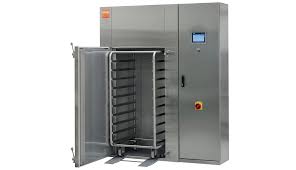In the world of industrial drying, the tray drying machine stands out for its straightforward efficiency and adaptability across a variety of industries. From pharmaceuticals to food processing, this machine offers a reliable method for dehydrating solids with consistency and precision. Here, we explore the effectiveness of tray drying machines by detailing their operational advantages, supported by concrete data and industry-specific applications.
Optimal Drying Efficiency for Various Materials
The tray drying machine is designed to accommodate a wide range of materials, from granular powders to thick pastes. It operates by spreading the product thinly across trays, which are then placed inside a heated chamber. The design allows for uniform heat distribution across the trays, which is critical for achieving even drying without over-processing any part of the material. For example, in the food industry, a tray dryer can reduce moisture content from 50% to just 5% in several hours, depending on the product and settings, demonstrating its capability to handle substantial moisture removal efficiently.
Control and Flexibility in Drying Operations
Flexibility is a significant advantage of the tray drying machine. Operators can adjust temperature settings, airflow, and drying times to suit the specific moisture content and temperature sensitivity of the material. This adaptability makes the tray dryer particularly effective in industries where precise moisture control is crucial, such as in the production of pharmaceuticals and specialty chemicals. Additionally, the ability to process multiple trays simultaneously allows for high throughput, which can be scaled up or down according to production demands.

Energy Efficiency and Cost Effectiveness
Despite its powerful drying capabilities, the tray drying machine is engineered to optimize energy usage. Many models are equipped with heat recovery systems that recycle the heat generated within the drying chamber, thereby reducing overall energy consumption. This efficiency can result in energy savings of up to 30% compared to less advanced drying technologies. Moreover, the operational costs are further minimized by the machine's low maintenance requirements and durable design, which ensures long-term reliability and reduces the need for frequent replacements or repairs.
Uniform Product Quality
The consistent heat distribution and controlled drying environment within a tray dryer ensure that each batch achieves uniform dryness, which is essential for maintaining quality standards. This consistency is particularly valuable in the production of food products and pharmaceuticals, where moisture levels can significantly impact the stability and effectiveness of the final product. The tray dryer's ability to maintain a controlled drying cycle means that products are consistently processed to the exact specifications required.
Ideal for Small to Medium Batch Processing
The tray drying machine is especially effective for small to medium batch processing, where precision and batch uniformity are paramount. This capability allows businesses to maintain high-quality standards while also experimenting with new product formulations without the risk of large-scale waste. Its capacity to handle varied batch sizes flexibly makes it an indispensable tool for R&D and specialty production lines.
Enhance Your Drying Process with Advanced Technology
Implementing a tray drying machine in your production setup can dramatically improve the efficiency and quality of your drying processes. With its capability to handle diverse materials, adjust to different production scales, and operate with high energy efficiency, the tray dryer stands as a testament to advanced drying technology. For further details on how this equipment can optimize your operations, consider exploring the benefits of a state-of-the-art tray drying machine. This investment can transform your production capabilities, ensuring that your products meet the highest standards of quality and efficiency.